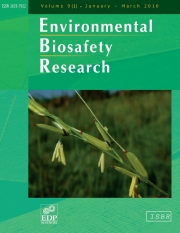Article contents
Biosafety considerations for selectable and scorable markers used in cassava (Manihot esculenta Crantz) biotechnology
Published online by Cambridge University Press: 15 November 2005
Abstract
Cassava is an important subsistence crop grown only in the tropics, and represents a major source of calories for many people in developing countries. Improvements in the areas of resistance to insects and viral diseases, enhanced nutritional qualities, reduced cyanogenic content and modified starch characteristics are urgently needed. Traditional breeding is hampered by the nature of the crop, which has a high degree of heterozygosity, irregular flowering, and poor seed set. Biotechnology has the potential to enhance crop improvement efforts, and genetic engineering techniques for cassava have thus been developed over the past decade. Selectable and scorable markers are critical to efficient transformation technology, and must be evaluated for biosafety, as well as efficiency and cost-effectiveness. In order to facilitate research planning and regulatory submission, the literature on biosafety aspects of the selectable and scorable markers currently used in cassava biotechnology is surveyed. The source, mode of action and current use of each marker gene is described. The potential for toxicity, allergenicity, pleiotropic effects, horizontal gene transfer, and the impact of these on food or feed safety and environmental safety is evaluated. Based on extensive information, the selectable marker genes nptII, hpt, bar/pat, and manA, and the scorable marker gene uidA, all have little risk in terms of biosafety. These appear to represent the safest options for use in cassava biotechnology available at this time.
Information
- Type
- Research Article
- Information
- Copyright
- © ISBR, EDP Sciences, 2005
References
- 11
- Cited by

